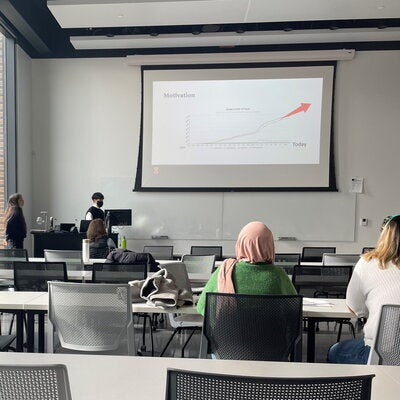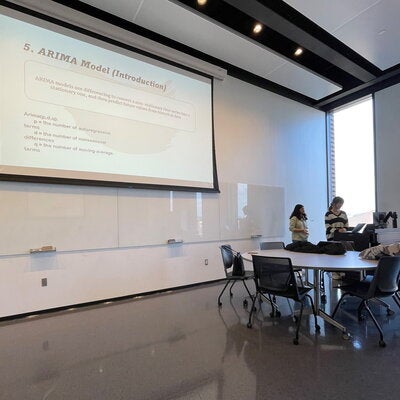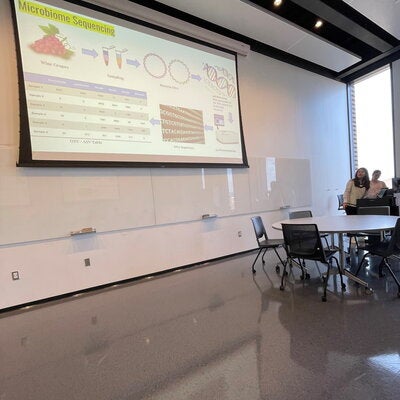
On December 7th, students and faculty gathered for the Fall 2022 Undergrad Research Symposium. URES allows students to work with experienced faculty on a research project, which is then presented at the end-of-semester event. I visited the Campus Instructional Facility to see the different types of research that had been conducted this semester.
I first spoke with Gillian Gabriel, the event’s coordinator. Ms. Gabriel oversees the matching of students with their faculty advisors. When a student applies for URES, they explain their research interests. From there, they are chosen by faculty who specialize in those fields to work alongside them for the semester. Different faculty members volunteer to take part in the program each semester. Gillian explained that the research event is always her favorite part of the year. She said, “I really love watching the students' presentations. Because I’m not a statistics person, I like having our students explain some things that they’re interested in working on so that I can understand more.” When Ms. Gabriel spoke of the event’s impact for students, she was quick to clarify that they aren’t the only group who benefits from URES. The nature of the program allows for undergraduates to intimately connect with a faculty member over the topic of shared research. Often, these connections last into post-grad life, and are valued by both parties. Gillian Gabriel said, “It is a mutually beneficial relationship between them, and I like being able to facilitate that.”
Next I spoke with URES director Steven Culpepper. I asked him about the impact that research experience can have on an undergraduate’s education. He replied, “Research is transformational for students. It gives them a sense of how they can use statistics in their lives, and provides them an opportunity to learn more about the kinds of ways people use statistics in the real world. [...] It’s a chance to learn about what’s possible.” Since the URES program allows students to have a say in their research assignments, each end-of-semester showcase is rich with variety. After speaking with some of the faculty in charge, I was interested to see what topics were explored this semester.

The first presentation I saw at the event was by Eliana Chandra and Tom Shin: Host Heterogeneity and SARS-CoV2: From Vaccine Inequity to Variants of Concern. The presenters began by explaining that, like many, they were worried about the prolonged nature of the Coronavirus Pandemic. Specifically, they were concerned with how someone’s socioeconomic status affects their ability to access Covid vaccinations. Using publicly available data, Chandra and Shin found that within the countries they inspected, there was indeed an inequity of vaccine distribution.
After the presentation, I was able to speak with Tom Shin about his involvement in the Undergraduate Research Event. He expressed that he wanted to study biostatistics but couldn’t find many courses at UIUC that captured this interest, but URES allowed him to explore this field with greater depth. Shin said the program was very informative, and helped him decide on his future plans for graduate school.
I also spoke with one of Shin’s mentors for the project, doctoral student Sophie Larson. They expressed the importance this research project had to them. Larson shared that projects like this wouldn’t be possible without the help of undergraduates like Shin and Chandra. “The work that we’re doing will be part of my dissertation, and we’re publishing. It’s really a lot of work to do all this data collection and analysis- it wouldn’t be possible for just one person to collect. We’re able to make much more robust projects because of the involvement of the undergrads.”
I wanted to see what other fields were explored at the symposium. I met Emily Hasson and Katherine Christensen, who studied behavior and personality. I asked why they decided to take part in URES. Christensen replied, “I hadn’t gotten a chance to do any research yet. (…) It definitely moved my interest more towards research. Working with Professor Culpepper and the doors that that opens- I feel like I have more opportunity for the future.” I asked about how they choose their topic of research, to which Hasson explained, “The psych classes are pretty qualitative, but we were able to get into more of the math and modeling with URES.” I was beginning to notice a pattern. URES seems to attract students who are eager about research, have niche academic interests, or both.
At this past semester’s Undergraduate Research Symposium I got to speak with program coordinators, faculty and graduate mentors, and student researchers. All these parties showed me the opportunity that becomes available when collaboration is encouraged. After hearing from some of the mentors, I saw exactly what Gillian Gabriel meant when she said this is a mutually beneficial program. URES is an incredible opportunity for undergraduates to experience research, while providing unparalleled connections.
If you’d like to learn more about Undergraduate Research Experience, you can find information on the Statistics website! https://stat.illinois.edu/research/undergraduate-research
Elizabeth McNutt
2023-01-30
Elizabeth McNutt is the staff writer for the Department of Statistics. If you have news to share, please contact the Statistics news group at stat-office@illinois.edu.
A complete list of the URES students and their projects can be viewed below.
Katherine Ann Christensen and Emily Page Hasson – mentored by Steven Culpepper
Using behavior to predict latent personality states with a Hidden Markov Model
The premise of this project is to model human personality using behavioral data. We introduced a hidden markov model to predict transitions between different latent personality states based on the Objective Personality System framework. We used simulations to illustrate how the model could be used on real sampled data.
Eliana Chandra and Tom Shin – mentored by Pamela Martinez
Host Heterogeneity and SARS‐CoV‐2: From Vaccine Inequity to Variants of Concern
Using publicly available data from dozens of countries with thousands of sub‐national locations, we examined temporal trends of vaccination rates across high and low socioeconomic groups at the sub‐national level. Our analyses show two distinct vaccination strategies: one characterized by a rapid initial roll‐out, quickly reaching half of the vaccination potential, then slowing, and a second strategy that is slow to begin but reaches a steady state more rapidly. Informed by these observed patterns, we implemented a model incorporating socioeconomic groups, with heterogeneity in the force of infection and vaccination rates, to track the immune histories of individuals exposed to different variants of concern. This second part of the project aimed to characterize the impact of bivalent boosters in low‐ and middle‐income countries with limited access to the SARS‐CoV‐2 vaccine.

Shangyun Zhangliang – mentored by Georgios Fellouris
A comparison of statistical procedures for post‐ marketing safety surveillance.
We consider various statistical signal detection methods for the monitoring of spontaneously reported adverse events of medical products. We generate synthetic data in order to design and compare these methods, and we apply them to data from the FDA adverse event reporting database.
Jonathan Kang and Zijun Yu – mentored by Lelys Bravo De Guenni
Analysis of Heat Wave Trends in Illinois
With global warming becoming a crucial issue worldwide, the goal of our project is to analyze the nature and current trends of heat waves in Illinois over a historical period (1989‐2021). To determine the occurrence of a heat wave, we use air temperature and relative humidity data from the Illinois Water and Atmospheric Resources Monitoring (WARM) network to calculate a heat wave index and its excess values over a local threshold for two locations: Champaign and the Chicago area. Next, we describe the frequency, duration and intensity of heat waves using a continuous Rectangular Pulses Poisson Process model (RPPM). The RPPM is fitted to the historical data by preserving the first and second order moments of the observed daily heat wave index during the summer periods. A Moving Block Bootstrap was implemented to investigate the variability of the RPP process parameters over several decades during the study period.
Yixin Zhou and Elina Mehra – mentored by Hyoeun Lee
Stock price prediction using various time series models
In this study, we focus on the comparison of time series models for Google stock price prediction. We use various models including linear regression, ARIMA, ARCH, dynamic regression, and Exponential Smoothing (Holt‐Winters). We use train‐test split to evaluate the forecast accuracy.

Heqi Yin and Ziyang Zheng – mentored by Shulei Wang
Differential Abundance Analysis of Microbial Compositional Data in Wine Grapes over Different Regions and Cultivars
The microbes harbored in wine grape surface play an essential role in the grape’s growth and wine quality. However, it still lacks a complete understanding of how the grape‐surface microbiota interacts with geographical patterns and other environmental factors. In this project, we apply several differential abundance analysis methods, such as Zicoseq and ANCOM_BC, to identify microbial species associated with geographical regions and cultivars. These findings can help accumulate insight into the grape‐surface microbiome community and potentially lead to a new strategy to improve wine quality.
Joey Shallat – mentored by James Balamuta
Establishing a Design of Experiments (DoE) Workflow
When Rokwire began in 2019, the set of features available for interaction within the Rokwire framework was low. After developing the platform further, new features have been added that augment existing interactions or led to new interactions entirely. Under this project, we seek to establish a way to understand at a fundamental level how effective new features are based on engagement. We aim to develop a framework following design of experiments principles for looking at how features are received upon introduction and what ripple effect occurs with older features to better assign development time.